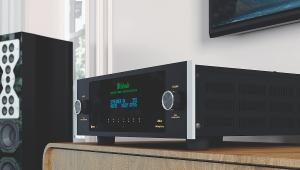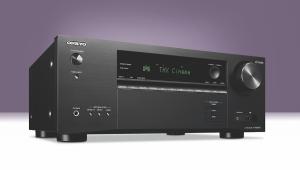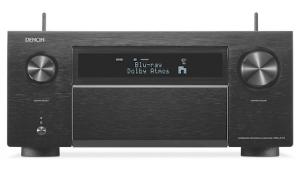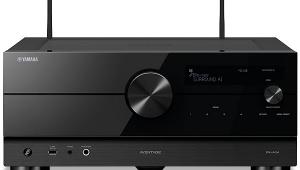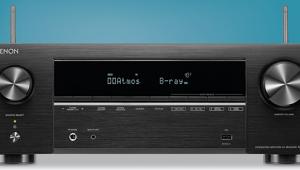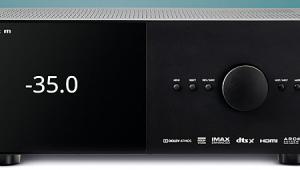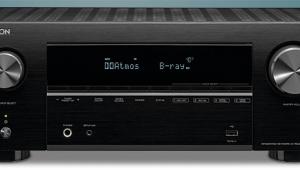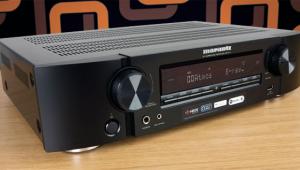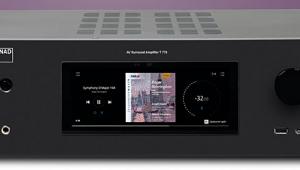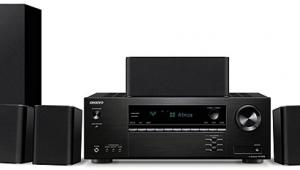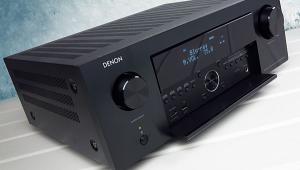Pioneer VSA-LX805 AV receiver review

 After a period of absence, Pioneer wants to return to its former position as one of the main AV receiver brands. And what's the best way to go about this? By launching an all-singing, all-dancing 11-channel model to compete with the similarly specified amps of its rivals. Enter the VSA-LX805.
After a period of absence, Pioneer wants to return to its former position as one of the main AV receiver brands. And what's the best way to go about this? By launching an all-singing, all-dancing 11-channel model to compete with the similarly specified amps of its rivals. Enter the VSA-LX805.
This Pioneer flagship ticks all the boxes, with support for Dolby Atmos, DTS:X, IMAX Enhanced and – if you've updated the firmware – Auro-3D (including the excellent Auro upmixer). There are streaming options galore too, with the sometimes clunky DTS Play-Fi joined by Apple AirPlay 2 and Chromecast. It's also Roon Ready, which is unusual for an AV receiver but good news for those who have shelled out on Roon to manage their music listening.
The VSA-LX805 sells for £3,099, but to soften the blow it's bundled with a full Dirac Live licence (normally $349). That's noteworthy, because some AVR manufacturers don't bundle a Dirac licence at all, or include one limited to correction below 500Hz.
Four subs?
Like all the cool kids currently in the AV receiver market, the VSA-LX805 (there's a VSX-LX805 model in the US, which includes a radio tuner) is labelled as an 11.4 unit – the '4' being where the hype is. Running four subwoofers is being touted as the next big thing in home cinema sound, in part due to Dirac Live supporting it.
And, indeed, Pioneer's receiver can manage four subwoofers (and even has connection for a passive subwoofer), although its functionality is only two separate channels, grouping two on each. Is this a real issue? Well, if you were planning to place a sub in every corner of your room, you'd get more control with four independent channels. However, if you do spring for Dirac Live Bass Control Multi Subs (which the Pioneer will work with), the software should be able to produce a good result with two.
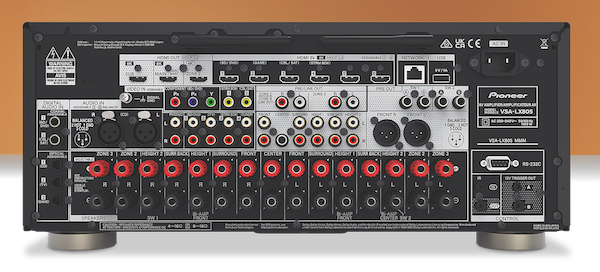
You're not forced to use Dirac here, of course, as the VSA-LX805 also has Pioneer's own MCACC calibration onboard. Even though the interface for this software feels ancient, running it in automatic mode as a 'quick 'n' dirty' option delivered acceptable results. The rest of the Pioneer interface is more up-to-date, although does feel sparse and uninformative compared to the new platform used by Denon and Marantz.
This receiver is heavy on features, but also literally heavy at 21.5kg, this heft coming in part from its large 'Direct Energy' power transformer. There's a claimed 150W per channel of juice on offer, measured at 8ohm driving two full-range channels, from a symmetrical amp layout mounted to internal heatsinks. D/A conversion, meanwhile, is tackled by two ESS ES9026PRO 'Hyperstream' chips.
The VSA-LX805's styling finds Pioneer not straying far from its established receiver template. There's nothing wrong with it, and the brushed metal faceplate is pleasing, but it's far from exciting.
The suite of connections is more likely to get your pulse racing, as the unit has six rear-side HDMI 2.1 inputs and three outputs (two of which offer 4K/120 and 8K/60 playback) that can be assigned to separate zones. All relevant HDR standards are covered, and there's support for VRR and ALLM. Retro console collectors can also connect their antiques to the VSA-LX805's legacy video inputs, while audiophiles are offered a rare balanced XLR input next to five single-ended ones (including an MM phono input for a turntable). Balanced pre-output connectivity for the main L/R channels is unusual too.
Pin-point performance
Pioneer's receiver was wired to a 5.1.4 setup based on DALI Rubicon and Alteco speakers, with a ELAC Sub 2050 delivering LFE thrills. After comparing MCACC calibration with Dirac, I opted for the latter. This is definitely the key to unlocking the best performance, as I found it added real refinement to the VSA-LX805's sound. And while there's work involved with Dirac, Pioneer's app offers a quicker way to take measurements if you don't fancy the optimal laptop/calibrated mic setup.
Post-calibration, I was thrilled by the dimensionality on offer when streaming Blue Beetle from an Apple TV 4K box. For example, when security forces break into the Reyes family home the helicopters passing overhead seemed to be positioned far above me, and caused another viewer in the room to involuntarily glance upward.
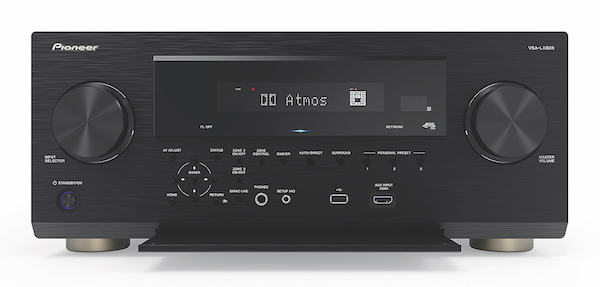
There were other moments during this fast-moving superhero flick when the VSA-LX805 delivered similar immersive surprises. This compensated for the amp's more measured portrayal of explosions and such, which feels like a tuning decision rather than a lack of wattage – in that regard it didn't seem lacking as it comfortably drove my DALI floorstanders. Pioneer's app also gives excellent control over the receiver for in-movie adjustment of channel levels and tonality.
The set-piece in the Norwegian forests (actually Scotland) in No Time To Die (4K Blu-ray) illustrates how Dolby Atmos can effectively be used to define huge spaces. It's subtle things, like the motorcycle engines roaring far off in the woods or the echoing of the pistol shots, and Pioneer's receiver presents these convincingly with detail and depth.
Again, some of the more explosive moments in this 007 flick saw the VSA-LX805 offering controlled aggression rather than all-out attack, but that made for a wonderfully balanced sound. And in complex scenes, the receiver excelled when exposing and positioning sound effects. A fine example of this was Blofeld's voice slowly rising out of a noisy party when Bond heads to Havana to team up with Paloma.
Making space
With music, both stereo and multichannel , the VSA-LX805 is especially good with compositions that contain
a lot of fine-etched detail. Tuvayhun (Blu-ray audio), a classical set recorded in a church space celebrated for its acoustics, with musicians and choir positioned in a circle to aid surround recording, might not be everyone's cup of tea, but there was no faulting the authenticity of the Pioneer AVR's delivery of its Auro 7.1.4 mix. Close your eyes and you are right there, in Trondheim's Nidaros Cathedral, thanks to the ability of the VSA-LX805 – aided by Dirac of course – to place delicate spatial cues in your listening room.
This strength makes this 11-channel amp very suited to soundtracks that rely on definition to tell their story – think Alfonso Cuarón's Roma or The Last of Us – but also a lot of music content. Combined with a long list of features (Dirac, Auro-3D) and connections to suit both legacy AV and high-end hi-fi gear, it means the VSA-LX805 is a very impressive all-rounder.
HCC Verdict: 4.5/5
Pioneer VSA-LX805
Price: £3,099
emea.pioneer-av.com
We say: Pioneer's new flagship AV receiver offers plenty of bells 'n' whistles, including Dirac, and a performance that gets right to the heart of immersive soundmixes.
Specifications
DOLBY ATMOS: Yes DTS:X: Yes IMAX ENHANCED: Yes MULTICHANNEL INPUT: No. MULTICHANNEL PRE-OUT: 11.4 MULTICHANNEL OUTPUT (CLAIMED): 11 x 150W (8ohm, 20Hz-20kHz, two-channel) MULTIROOM: Yes. Three zones HDMI: Yes. Yes. 7 x inputs; 3 x outputs AV INPUTS: 5 x digital audio (3 x optical and 2 x coaxial); 5 x analogue stereo DIMENSIONS: 435(w) x 185.5(h) x 468(d) WEIGHT: 21.5kg
FEATURES: MCACC calibration; Dirac Live room correction (w. paid upgrade available for Bass Control); Auro-3D; HDR10+ and Dolby Vision passthrough; 4K/120Hz and 8K/60Hz passthrough; VRR and ALLM; Pioneer Remote app (includes Dirac measurement, internet radio, music streaming); 2 x 32-bit DACs; four subwoofer outs (two channels); phono MM input; balanced XLR stereo input/pre-out; Roon Ready; DTS Play-Fi; Apple AirPlay 2; Chromecast; Bluetooth; Ethernet/Wi-Fi
 |
Home Cinema Choice #351 is on sale now, featuring: Samsung S95D flagship OLED TV; Ascendo loudspeakers; Pioneer VSA-LX805 AV receiver; UST projector roundup; 2024’s summer movies; Conan 4K; and more
|




